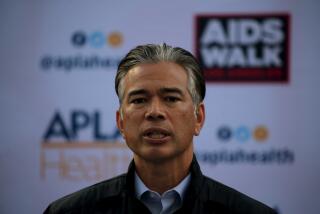Japan’s New Investment in Power : Union Bank Deal Signals Shift to a Drive for More Active Control
The proposed acquisition of Union Bank in Los Angeles by a subsidiary of one of Japan’s leading banks is the latest chapter in a story about the changing financial industry in the United States.
The $750-million investment in Union Bank by Bank of Tokyo’s affiliate, California First Bank, fits into a neat pattern in which Japanese banks and securities firms have followed their counterparts in manufacturing and real estate with direct investments in the U.S. economy.
The car manufacturers were once the most visible Japanese investors, with plants in Kentucky, Tennessee and Ohio, and a joint venture with General Motors in Fremont, Calif. But in recent months, the banks and other financial companies have become more prominent.
In August, 1986, Sumitomo Bank of Japan proposed investing $500 million in Goldman, Sachs & Co., the most respected securities firm on Wall Street. The transaction was approved by the Federal Reserve Board only after repeated assurances from Sumitomo that it would not exercise any control over Goldman Sachs.
Following that deal came Nippon Life Insurance’s investment of an identical amount in Shearson Lehman Bros., which recently became Shearson Lehman Hutton, one of the nation’s two largest brokerages.
Even the $350 million invested in Bank of America last year by a consortium of Japanese banks was a passive contribution that carried no management overtones.
The acquisition of Union Bank from its British owners, Standard Chartered, will give Japanese-owned banks control of five of the 10 largest banks in California and that control is what differentiates these types of deals from the passive investments.
“What you’ve got, once you own the bank or have control of the bank, is control of a good deal of economic power as far as where and how loans are to be made and to whom,” Rep. Fernand J. St Germain (D-R.I.), chairman of the House Banking Committee, once told a television reporter. “A manufacturing plant just manufactures whatever the product might be. That’s an investment for profit. However, when we talk about the purchase of a bank, that’s an investment for power.”
William H. Davidson, a professor of international management at USC who has written extensively on Japanese investment in the United States, said the Union Bank deal may represent a new era in Japanese investing.
“It may suggest a shift toward direct control,” Davidson said. “Goldman Sachs, Shearson Lehman, Bank of America--those have been minority positions, not controlling investments. This is a controlling investment, and we may see much more of this kind of thing in the future.
“The heart and soul of the Japanese economy is financial control. The extension of that type of control to the U.S. system is a very critical issue.”
Emerged in 1984
The Japanese emerged in 1984 as major purchasers of U.S. Treasury bonds and American stocks, and their activity in that arena increased dramatically until the stock market crash in October. The crash put the Japanese and many other major investors on the sidelines, at least for now. At the same time, Japanese banks have made substantial inroads into the U.S. banking business. They accounted for 9% of the nation’s banking assets in the middle of last year, according to the Federal Reserve, more than double their share at the start of the decade.
Their volume of commercial and industrial loans is increasing at a rate that is five times faster than the rate of U.S. banks.
Part of the reason for the spurt by Japanese banks is their sheer size. Eight of the world’s 10 largest banks are Japanese, and the strong yen has given them enormous investment power. They also have more leverage from their resources than U.S. competitors because they have less stringent capital requirements.
The Japanese acquisition of California banks has been particularly irritating to the big East Coast banks, which are prohibited by state law from buying California banks until interstate banking barriers drop in 1991. However, the law does not apply to foreign banks or their subsidiaries here.
“We feel it is sort of a sad commentary that a U.S.-based bank can’t participate in the California market that foreign banks are exploiting,” said Richard S. Braddock, the head of retail banking for New York’s Citicorp, the nation’s largest bank.
99% American
Some Japanese bankers are sensitive to potential criticism, which is one reason that California First Bank’s president and chief executive, Seishichi Itoh, played down the Bank of Tokyo role in the Union deal and stressed in an interview that Bank of Tokyo opened its first office in California in 1886. The name was changed in 1975.
“We manage this as an American bank,” Itoh said. “Ninety-nine percent of our employees are American and most of our customers are American.”
California First, headquartered in San Francisco and the state’s sixth-largest bank, has a consumer base in Southern California and strong international ties to Japanese companies. Union Bank, run by Chairman John F. Harrigan, is viewed by analysts as complementary because of its base as a lender to medium-sized businesses and real estate developers in Southern California.
“This merger will give California First a substantially enhanced presence in California, although it will still be far smaller than the major banks in the state,” said Paul H. Baastad, an analyst in the San Francisco office of the S. G. Warburg investment firm.
The state’s largest banks are Bank of America, Security Pacific, Wells Fargo and First Interstate of California.
CALIFORNIA’S 10 LARGEST FOREIGN-OWNED BANKS
If the Union Bank-California First deal goes through, all but Hibernia Bank and Bank of the West will be Japanese-owned.
Assets (Dec. 31, 1987) Bank Billions of $ Union Bank 9.1 California First Bank 6.1 Sanwa Bank of California 5.3 Bank of California 4.7 Sumitomo Bank of California 3.57 Mitsui Manufacturers 1.8 Tokai Bank of California 1.79 Hibernia Bank 1.57 Mitsubishi Bank of California 1.56 Bank of the West 1.48
More to Read
Inside the business of entertainment
The Wide Shot brings you news, analysis and insights on everything from streaming wars to production — and what it all means for the future.
You may occasionally receive promotional content from the Los Angeles Times.










